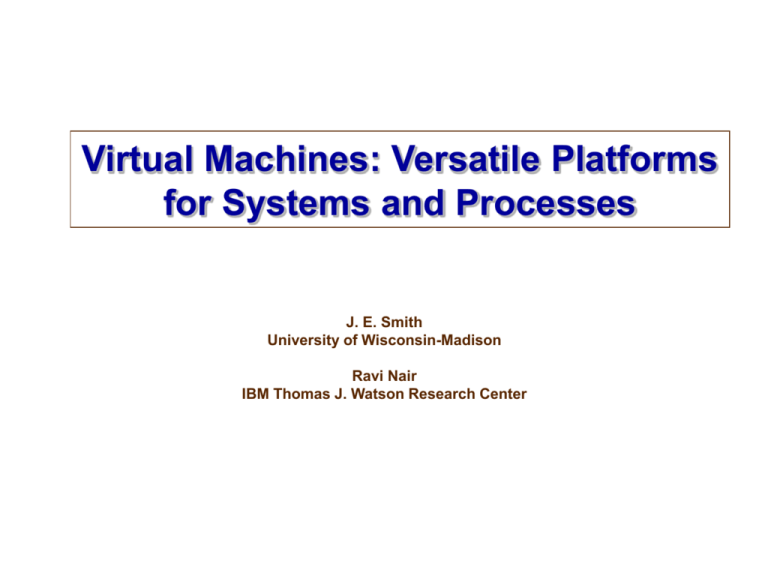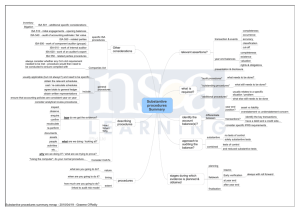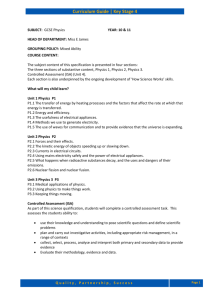
Virtual Machines: Versatile Platforms
for Systems and Processes
J. E. Smith
University of Wisconsin-Madison
Ravi Nair
IBM Thomas J. Watson Research Center
INTRODUCTION
This material is based on the book, Virtual Machines: Versatile Platforms for
Systems and Processes, Copyright 2005 by Elsevier Inc. All rights reserved.
It has been used and/or modified with permission from Elsevier Inc.
Course Objectives
Study VM architectures and applications
Study key implementation technologies
Focus on architecture and microarchitecture
aspects
Cover significant case studies
Introduction
3
Introduction
Why are virtual machines interesting?
They allow transcending of interfaces
(which often seem to be an obstacle to innovation)
They enable innovation in flexible, adaptive software & hardware,
security, network computing (and others)
They involve computer architecture in a pure sense
Virtualization will be a key part of future computer systems
A fourth major discipline? (with HW, System SW, Application SW)
Introduction
4
Advantages of Standard Interfaces
Major design tasks are decoupled
• In space and time
Different hardware and software
development schedules
Software can run on any machine
supporting a compatible interface
MacIntosh apps.
MacOS
PowerPC
Introduction
Windows apps.
Windows
x86
Linux apps
Linux
x86
5
There are also disadvantages…
Software compiled for one ISA will not run on
hardware with a different ISA
•
Even if ISAs are the same, OSes may differ
•
Apple Mac (PowerPC) binaries on an x86?
Windows NT applications on a Solaris x86?
Binary may not be optimized for the specific hardware
platform it runs on
•
Intel Pentium 4 binaries on an AMD Athlon?
MacIntosh apps
MacOS
x86
Introduction
Windows apps.
Linux
x86
6
Disadvantages (contd.)
Innovation may be inhibited by fixed ISA
•
•
Hard to add new instructions
OR remove obsolete ones
What was the most recent (successful) new ISA?
Or new OS?
Difficult for software to interact directly with
implementation
•
•
•
•
Performance features
Power management
Fault tolerance
Software is supposed to be implementation independent
Introduction
7
Hardware Resources
Conventional system software manages
hardware resources directly
•
•
An OS manages the physical memory of a specific
size
I/O devices are managed as physical entities
Difficult to share resources except through OS
•
•
All users of hardware must use the same OS
All users are vulnerable to attack from other users
sharing the resource (via security holes in OS)
Introduction
8
Abstraction
Software
Computer systems are built
on levels of abstraction
Higher level of abstraction
hide details at lower levels
Example: files are an
abstraction of a disk
Application
Programs
fileLibraries
file
Operating System
abstraction
Drivers
Memory
Manager
Scheduler
Execution Hardware
System Interconnect
(bus)
Memory
Translation
Controllers
Controllers
I/O devices
and
Networking
Main
Memory
Hardware
Introduction
9
Virtualization
An isomorphism from guest to host
Map guest state to host state
• Implement “equivalent” functions
•
e(Si )
Si
Sj
Guest
V(Si )
V(Sj )
e'(Si')
Si'
Sj'
Host
Introduction
10
Virtualization
Similar to abstraction
Except
• Details not necessarily hidden
Construct Virtual Disks
•
•
•
virtualization
file
file
As files on a larger disk
Map state
Implement functions
VMs: do the same thing
with the whole “machine”
Introduction
11
The “Machine”
Different perspectives on
what the Machine is:
OS developer
Compiler developer
Application programmer
Application
Programs
Libraries
Operating System
Execution Hardware
Instruction Set
Architecture
Application
Program
Binary
Interface
Interface
••
•
•
ISA
API
ABI
Major
division
User
User ISA
ISA
++ library
OSbetween
calls
calls hardware
and software
Introduction
System Interconnect
(bus)
I/O devices
and
Networking
Memory
Translation
Main
Memory
12
The “Machine”
Different perspectives on
what the Machine is:
OS developer
Application
Programs
Libraries
Operating System
Execution Hardware
Instruction Set Architecture
•
•
ISA
Major division between hardware
and software
Introduction
System Interconnect
(bus)
I/O devices
and
Networking
Memory
Translation
Main
Memory
13
The “Machine”
Different perspectives on
what the Machine is:
Compiler developer
Application
Programs
Libraries
Operating System
Execution Hardware
Application Binary Interface
•
•
ABI
User ISA + OS calls
System Interconnect
(bus)
I/O devices
and
Networking
Introduction
Memory
Translation
Main
Memory
14
The “Machine”
Different perspectives on
what the Machine is:
Application programmer
Application
Programs
Libraries
Operating System
Execution Hardware
Application Program Interface
•
•
API
User ISA + library calls
Introduction
System Interconnect
(bus)
I/O devices
and
Networking
Memory
Translation
Main
Memory
15
Virtual Machines
add Virtualizing Software to a Host platform
and support Guest process or system on a Virtual Machine (VM)
Example: System Virtual Machine
Applications
Applications
Guest
OS
VMM
Virtualizing
Software
Host
Hardware
"Machine"
Introduction
OS
Virtual
Machine
16
The Family of Virtual Machines
Lots of things are called “virtual machines”
IBM VM/370
Java
VMware
Some things not called “virtual machines”, are virtual machines
IA-32 EL
Dynamo
Transmeta Crusoe
Introduction
17
Taking a Unified View
“The subjects of virtual machines and
emulators have been treated as entirely
separate. … they have much in common. Not
only do the usual implementations have many
shared characteristics, but this commonality
extends to the theoretical concepts on which
they are based”
-- Efrem G. Wallach, 1973
Introduction
18
Major Program Interfaces
ISA Interface -- supports all conventional
software
System Calls
Application Software
Operating System
System ISA
User ISA
ISA
Application Binary Interface (ABI)
-- supports application software only
Application Software
System Calls
Operating System
System ISA
Introduction
User ISA
ABI
19
System Virtual Machines
Provide a system
environment
Constructed at ISA
level
Persistent
Examples: IBM
VM/360, VMware,
Transmeta Crusoe
guest
guest
process process
guest
process
guest
guest
guest
process process process
Guest OS
Guest OS2
VMM
VMM
HOST PLATFORM
virtual
network communication
Introduction
20
System Virtual Machines
Native VM System
•
•
•
Machine
VMM
VMM
HostHost
OS OS
VMM
User-mode Hosted VM
•
VMM privileged mode
Guest OS user mode
Example: classic IBM
VMs
Virtual
Virtual
Machine
Machine
Virtual
VMM runs as user
application
Non-privileged
modes
Privileged
Mode
Hardware
Hardware
Hardware
Dual-mode Hosted VM
•
•
Parts of VMM privileged;
parts non-privileged
Example VMware
Introduction
21
Process VMs
Execute application binaries with an ISA different from
hardware platform
Couple at ABI level via Runtime System
Examples: IA-32 EL, FX!32
Guest
Application Process
Virtualizing
Software
Runtime
OS
Host
Application Process
Virtual
Machine
Machine
Hardware
Introduction
22
Process Virtual Machines
Constructed at ABI level
Runtime manages guest
process
Not persistent
Guest processes may
intermingle with host
processes
As a practical matter, guest
and host OSes are often
the same
Dynamic optimizers are a
special case
Examples: IA-32 EL, FX!32,
Dynamo
Introduction
guest
process
host
process
runtime
guest
process
guest
process
runtime
host
process
runtime
create
HOST OS
file sharing
Disk
network communication
23
Same-ISA Dynamic Binary Optimizers
Optimize Binary at Runtime
An ABI level optimization
A type of Process VM
Example HP Dynamo
•
•
Can optimize for dynamic
properties of program
Can optimize for a specific
processor implementation
Introduction
HP Apps
UNIX
HP PA
24
HLL VMs
Java and CLI are recent examples
Binary class files are distributed
“ISA” is part of binary class format
OS interaction via APIs (part of VM platform)
Java Binary Classes
Java VM
Architecture
Introduction
VM
implementation
VM
implementation
VM
implementation
Sparc
Workstation
x86
PC
Apple
Mac
25
High Level Language Virtual Machines
Raise the level of abstraction
• User higher level virtual ISA
• OS abstracted as standard libraries
Process VM (or API VM)
HLL Program
HLL Program
Compiler front-end
Intermediate Code
Compiler
Portable Code
( Virtual ISA )
Compiler back-end
VM loader
Object Code
(ISA)
Virt. Mem. Image
VM Interpreter/Translator
Loader
Introduction
Memory Image
Host Instructions
Traditional
HLL VM
26
Co-Designed VMs
Perform both translation and
optimization
VM provides interface between
standard ISA software and
implementation ISA
Primary goal is performance or
power efficiency
Use proprietary implementation ISA
Transmeta Crusoe and IBM Daisy
best-known examples
Introduction
X86 Apps
Windows
VLIW
27
Composition
apps 1
OS 1
apps 2
OS 1
ISA 2
Introduction
28
Composition: Example
Java application
JVM
Linux x86
VMware
Windows x86
Code Morphing
Crusoe VLIW
Introduction
29
Summary (Taxonomy)
VM type (Process or System)
Host/Guest ISA same or different
Process VMs
same ISA
Multiprogrammed
Systems
HP
Dynamo
Introduction
different
ISA
IA-32 EL
FX!32
System VMs
same ISA
IBM VM/370
different
ISA
Virtual PC
for Mac
VMware
Java VM
MS CLI
Transmeta
Crusoe
30
Course Topics
Introduction & VM Overview
Emulation: Interpretation & Binary Translation
Process VMs & Dynamic Translators
Dynamic Binary Optimization
Co-Designed VMs
HLL VMs
System VMs
Emerging Applications
Introduction
31
Case Studies
Shade
Sun WABI
Compaq FX!32
HP Dynamo
VMware
Transmeta Crusoe
IBM Daisy
Intel VT-x
…. and others
Introduction
32



